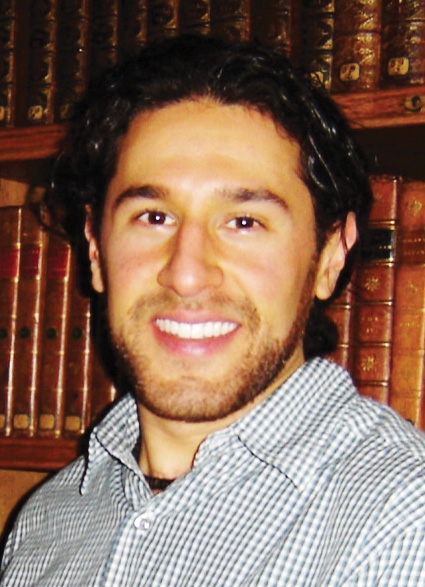
NEW ORLEANS (BP)–In a cramped room, students fix their eyes on a copy of Greek text, surrounded by glass cases containing copies of centuries-old Bibles and ancient texts. Some letters are clear, others nonexistent; holes in the text give the document the appearance of moth-eaten fabric.
Deciphering the mystery of the holes, wrought by time, weather and ancient wars, was the goal of students who were working in New Orleans Baptist Theological Seminary’s H. Milton Haggard Center for New Testament Textual Studies under Michael Theophilos, a 29-year-old Australian research scholar with a doctorate from Oxford who spent the fall semester at NOBTS.
It is the cross-disciplinary puzzle of language, history, archaeology, theology and science that, in part, drives Theolophils, who conducted a three-day workshop on papyrology, the study of papyrus, aimed at deciphering ancient Greek and Latin texts written on papyrus or other easily portable material.
The hands-on experience allowed students to experience reading papyrus texts in the original languages as well as English and examine what those texts — reflecting the fabric of daily life, such as ancient sales receipts and invitations to pagan feasts — mean for biblical interpretation.
The workshop’s goal, Theophilos said, was to give students a deeper understanding of the historical context of biblical events.
“The goal for any student of the text is to appreciate that the text we are reading comes from a very definite historical period,” Theophilos said. “It is not something that happened in the ambiguous distant past. It’s not something that is some kind of abstracted philosophical system we are reading in our text.”
While at present, the only New Testament manuscripts available are from the mid-second century, scholars do have access to original documents which chronicle life in the New Testament times. These extra-biblical documents bring a greater reality to the biblical text.
“It gives the Bible a greater humanity and historicity in the sense that it isn’t something that merely was manifested from thin air,” Theophilos said. “This is something that was in conversation with other documents in the ancient world.”
Trying to piece together ancient manuscripts is “like a big jigsaw puzzle,” Theophilos said. “There are going to be big gaps. One of the ways to piece things together is by understanding genre and context.
“Understanding genre is just as important as understanding language,” he said. For example, students of children’s fairy tales might find a manuscript with the words “Once __ a time” and know that the missing word was “upon” based on wording common to fairy tales. Similarly, a missing word from an ancient text can only be reconstructed with the appropriate knowledge of the genre.
But for every closed gap, there are countless mysteries and variants in the ancient texts to solve, using a combination of science, art, history, archaeology, theology, language and old-fashioned detective work.
Theophilos was drawn to the study of the ancient texts while teaching and preaching in Papua New Guinea. While doing outreach ministry in the outlying villages, he felt “a thirst to know more about the historical, political and religious history of early Christianity and Second Temple Judaism.”
Thirsting for more, Theophilos returned to Australia and immersed himself in Greek, Hebrew, Coptic and Latin. As he studied, a light clicked on.
“I began to see the tremendous way the text just opened up through the study of ancient documents,” he said.
Theophilos had high praise for the students he encountered at NOBTS and for the H. Milton Haggard Center. There, scholars labor over ancient texts, trying to solve the puzzle of the ancient world. And those discoveries have been shared with biblical scholars across the globe.
“At the basic level, [the center] is providing a very concrete tool to help people realize that the text that we have when we pick up our English versions has a very rich and complicated — but very interesting -– textual history,” Theophilos said. “It’s a tremendous lesson to learn. I think it’s a very helpful way for people to get into the issue and see the aspects involved in this sort of study.”
William Warren, director of the Haggard Center for New Testament Textual Studies and professor of New Testament and Greek at NOBTS, praised Theophilos’ contributions to scholarship at the seminary during the semester.
“In-depth understanding of the setting in which the biblical events took place requires studying the data from the time periods of the events,” Warren said. “Having a [visiting] specialist in some of that data has enhanced the experience of many students and faculty at NOBTS since he is an expert in the early papyrus manuscripts.”
Warren added: “He has opened windows into the world of Jesus and the early church by presenting and explaining the importance of letters, documents and New Testament fragments in lectures and a special workshop. His work is on the cutting edge of accessing the data that undergirds our understanding of the biblical world, with current work including the analysis of several additional New Testament papyrus fragments from the Oxyrhynchus finds in Egypt. His level of scholarship combined with his evangelical faith has provided a great example of how we can love God with all of our mind in the best possible sense.”
Because of the cross-disciplinary nature of papyrology, only a handful of universities are at the head of the field. The academic standards and demands are high. Knowledge of Greek must be impeccable. And, students of the ancient texts must have Job-like patience.
“One of the things I’ve tried to communicate to students here is that when you get into this area, there’s no need to rush,” Theophilos said. “When you do rush, you’re going to make some errors. It’s almost a tedious type of patience you need to have. Sometimes, that can be very frustrating. It’s not like you spend a half-hour then get an article published.”
Theophilos recalled one of the first manuscripts he studied.
“I spent at least two weeks reading five or six lines under the microscope. It requires language skills and a lot of patience. The things we’re looking at are not printed texts. They have a history of their own. They’re crumpled. They’re in dirt. They’re in sand.”
There is another virtue that comes into play when wrestling with ancient manuscripts that have survived time and war and weather and sand and silt.
“All learning and scholarship has to have an element of humility in the sense that ‘this is the best sense of the text that we have,'” Theophilos said. “It’s not being a relativist. It’s not being a postmodernist in any regard. One person has called it critical realism. We believe that there is something real there and we’re being critical about how we interact with that because we’re human beings. We bubble with emotions and hormones and all sorts of things that make us human. We’re not robots. We’re not scanning bar codes. It’s something more than that.”
–30–
Paul F. South is a writer for New Orleans Baptist Theological Seminary.
















